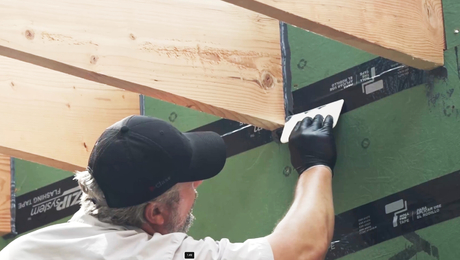Our shared garage is officially a tear down so I’m planning to build new shortly (crying on the outside for the cost, smiling on the inside for the new workshop!).
The current garage was built in the 1950’s and the 2×4 sticks have seen better days judging by the decay and sexy lean to the building. The foundation is the biggest problem: poured basically at ground level, it has many deep cracks and several sink points plus the ground/gravel floors.
Current building is a 22′ W x 21′ L shared garage (partition wall down middle). Doors that are being reused are 8′ x 6’6″ (non-insulated aluminum).
New Building: I’ll be using my side of the garage for a workshop so I want to build for a stable environment (dampness kills tools).
So my questions:
To minimize the amount of concrete removal and digging, I’m planning on doing the new slab (floating) so the building is 2′ wider and 3′ longer. I’ll take out the worst of the foundation and then dig 16″ below ground for footing and use 1/2″ re-bar and wire mesh.
-> Suggestions on the slab portion of the job?
-> Do I need to lay down 3/4 clear and poly or can I just go right over current?
Roof will be approx 6/12 pitch which will give me a nice amount of storage in the rafter space. Again, I’m after an environment that won’t destroy anything stored in the garage because of dampness.
-> Would you insulate this building (Toronto)? Finish walls with plywood (interior)?
If I’m to re-use the garage doors, is there an effective way of insulating my side instead of buying new?
As this is my first garage/workshop, any suggestions on how to make nice nice is appreciated. I’ve done my research and have a pretty good layout done (electrical, storage, work flow).
Cheers,



















Replies
I would make your doors wider if possible - 8' is pretty narrow. If you keep them you can surface-apply insulation (I think I saw a retrofit article in FHB once) - can't have exposed foam though.
My garage/workshop was a makeover, we used LVLs for the lumber loft floor and a pull-down attic stair, while one end is left open to the shop below to allow for longer lengths to be slid up for storage.
It has radiant heat in the new slab.
You have to insulate or you'll have wild temperature swings and resulting humidity swings (even if unheated).
Make sure you use a vapor barrier over existing - 8 mil (not 6 mil).
More outlets than you think you'll ever use. I have them in floor boxes too.
Jeff
Edited 10/11/2009 11:55 pm ET by Jeff_Clarke
Thanks Jeff.What type of radiant did you go with? Hydronic or ElectricalHow did you do your attic stair? I was thinking of 36" wide.Van G
Radiant is hydronic with Watts radiant ONIX tubing.
Standard attic stair ... but wider is gooder ;o).
Get aluminum not wood - mines a Werner.Shop walls are 5/8" painted birch ply with a very small 'vee' joint at meeting edges.
Edited 10/12/2009 12:33 am ET by Jeff_Clarke
I THINK I could answer the concrete part of your questions. The slab should be "thickened" around the edges down to the local frost line. Throw a pair of #5 rebars ( 5/8") in the trench for the footer. Put down a layer of GOOD gravel and compact it as much as you can. Next, that 6x6 wire mesh. Tie the sheets together with at least 12" lap ( two "squares") and keep the mesh of the gravel with small "bricks" made from the old foundation. But, put down layer of 6mil. poly between the gravel and the mesh. Next, pour this thickened slab and finish your garage.
As for those garage doors, add some ridgid foam insulation board to the inside of the door'd panels. Glue them in place with what ever constrction grade adhesive you have. Then cover the panels with some of that 6 mil. poly, taped in place to seal the doors.
"The slab should be "thickened" around the edges down to the local frost line."I still need to go down 4' for the footing even though it's a floating slab? I thought the advantage was that I could simply dig down 16' and pour as one continuous piece as opposed to a traditional footing and floor type of pour.
Van G
I'd check with your local "code" people about that. You COULD rest the slab's "edges on piers, turning the thickened edges into grade beams. The piers would go down to the frost line, the edge of the slab would need to be about 12" thick then. Add in some rebar to make the grade beams and be sure to "tie" them into the pier's tops. One pier per corner, and maybe one inbetween. Piers would be about 3' tall, and about 2'x2' square. How's that?" Although I have the right to remain stupid, I try not to abuse that right"
thought the advantage was that I could simply dig down 16' and pour as one continuous piece as >>>>>>>>>>>>>>>>>>>
That is fine. I live in upstateNY and have weathered many winters with floating slab foundations. Remember many people post on here with their local codes in mind. Yours may and will differ than theirs.
Check with your local BI, I suspect you will be fine with what you are planning
The foundation is the biggest problem: poured basically at ground level, it has many deep cracks and several sink points plus the ground/gravel floors.
To minimize the amount of concrete removal and digging, I'm planning on doing the new slab (floating) so the building is 2' wider and 3' longer. I'll take out the worst of the foundation
Big mistake.
The current problems are because of poor soil prep and unless you're pouring a bridge, they will reappear in your new slab.
Bite the bullet and remove all the old concrete, excavate any soil that has any organic material and any that looks like previous fill or old topsoil. Compact whats left with a Whaker or other "Jumping Jack" type compactor then backfill in 6" lifts with a mixed gravel that ranges in size fron fine sand to 1 1/2" and compact each lift.
I still need to go down 4' for the footing even though it's a floating slab?
Yes. Unless it's a, IIRC, whats called a Frost Protected Shallow Foundation. Anyway, it requires insulating the ground a distance equal to the frost line depth outside the footprint.
With a standard T footing, overdig it 10", compact the soil, add two 6" lifts mixed gravel, compacting each. Place two pieces of # 5 rebar on 3" chairs in the bottom with a #4 vertical 4' OC centered in the foundation wall to hold the top 2 horizontal #4 banding rebars. While you're at it, bond 20' of 9ga bare copper wire to one of the footing rebars with some 14 ga copper 2'OC and leave 10' above ground to bond to the ground tab in your breaker box. This is called a Ufer Ground and is very effective.
Before you pour the walls, add #4 Ell rebars 1' OC to extend into the 6"/8" thickened edge of the slab. Tie the to the two #4 banding rebars at the top of the wall. The banding bars just have to be spaced to hold the Ells in place. One at the top, the other about 10" down, assuming your Ells are 1'x1'. Add a single #4 banding rebar on top of the Ells about 10" inside the slab.
If you're going to heat the shop, add 2" watertight foam insulation to the inside of the outer form with coarse thread DW screws sized to penetrate the foam 1" to 1 1/2", spaced 1' OC along the edges of the foam sheets. Don't overtighten them at all. The concrete will strongly adhere to the foam and you can just rip the screws out. :>(
Insist the concrete men vibrate the footings and foundation walls.
If you've gone to the trouble of properly preparing the soil bed, order your concrete with minimal water and add a slump reducing, AKA, water reducing admix. Your 'crete supplier will respect you, but your 'crete men will hate you. They like weak, wet mud 'cuz it's easy to work.
Since you have done everything right, you won't need any rebar or remesh in the 4" thick slab, just some fiber of your choice. If you want, you can do a 6" slab and put #4 'bars on a 2' to 4' OC grid on 3" chairs. If your going to radiant heat it, sometimes above freezing, sometimes comfy, I would go with the 4" (really 3 1/2") slab for faster response times.
As for a radiant heat source, I'm WAGging that a 20-30 gal water heater ill do, but maybe we can get NRTRob to chime in.
SamT
A Pragmatic Classical Liberal, aka Libertarian.
I'm always right!
Except when I'm not.
HELP!!!!
see: OP's post #1 and my post #8
SamT
A Pragmatic Classical Liberal, aka Libertarian.
I'm always right!
Except when I'm not.
Hi Sam,from a heating perspective I would first say the building obviously needs insulation (that was an original question).for 400 insulated shop square feet in toronto, a water heater would probably do the job, but I am told that codes in Canada prohibit the use of a dedicated water heater. so then you're looking at a heat exchanger so one heater can do DHW and heating (stupid, I know).if it's a slab floor, single zone, it might be the one case for a tankless on demand doing heating duty... just make sure it's small... or electric, if local rates are low.Hope that helps,-------------------------------------
-=Northeast Radiant Technology=-
Radiant Design, Consultation, Parts Supply
http://www.NRTradiant.com
Thanks, Rob, for checking in.SamTA Pragmatic Classical Liberal, aka Libertarian.
I'm always right! Except when I'm not.